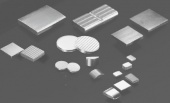Low and Medium Electrical Loads
Switching processes at low and medium electrical loads are experienced for example in relays and switches for the measuring technology, telecommunications, automotive usage and appliances. The switching voltage, ranges from μV to 400V with currents between μA and about 100A.
Guided by empirically developed arc-limiting graphs, typical switching processes can be distinguished. As illustrates, voltage and current determine if switching occurs without arcing, if it resul...


